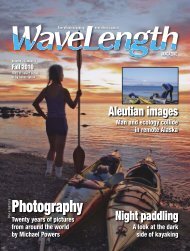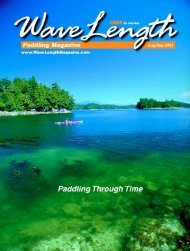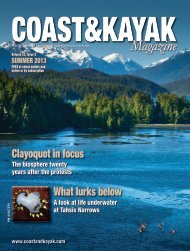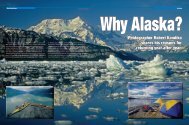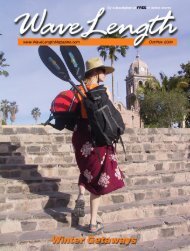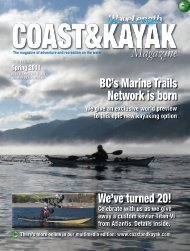Download - WaveLength Paddling Magazine
Download - WaveLength Paddling Magazine
Download - WaveLength Paddling Magazine
You also want an ePaper? Increase the reach of your titles
YUMPU automatically turns print PDFs into web optimized ePapers that Google loves.
drinking hot cocoa beside a toasty fire, or<br />
in the tropics. Pratt-Johnson’s book has the<br />
most comprehensive information available<br />
about Island paddling, but I warn you that<br />
it’s dated. The book was written in 1984<br />
and while the natural landscape has altered<br />
very little, the human landscape has<br />
changed tremendously. Some roads no<br />
longer lead where they once did, some<br />
access points are no longer public, and<br />
some formerly free camping spots have<br />
been lost down the whirlpool of economic<br />
development. For this reason, I’ll keep my<br />
descriptions general.<br />
For up-to-date information on rivers, contact<br />
local paddling stores, request current information<br />
on the Whitewater Kayaking Association<br />
of BC’s web-based message board<br />
(www.whitewater.org), or for the latest on<br />
North Island rivers visit Jeffrey Holden’s<br />
Home page (http://ourworld.compuserve.<br />
com/homepages/jholden). You can also visit<br />
www.coastalbc.com for photos and stories<br />
about Island whitewater, and www.<br />
vancouverisland.com/Recreation/<br />
whitewaterkayak for short write-ups about<br />
some rivers not included in the Pratt-Johnson<br />
book or here.<br />
1. Koksilah River, near Shawnigan Lake,<br />
has two runs that are available only after a<br />
good downpour. The upper run is a short<br />
Class II with a couple of Class III drops that<br />
are easy to portage. The lower run through<br />
a canyon is about 15 km long and offers<br />
more of a challenge. Class III and IV water<br />
is interrupted by two difficult drops with<br />
awkward portages, and one easy, mandatory<br />
portage.<br />
2. Cowichan River is possible to paddle<br />
all year, although it can be extremely low<br />
in the summer. Located west of Duncan,<br />
this Class III- run is within a provincial park,<br />
which gives it a beautiful wilderness setting.<br />
A lovely, easy river at low levels, it<br />
can provide a lively challenge at high levels.<br />
At only 4 km long, it is not strenuous<br />
and the whole run can be scouted from<br />
trails along the shore, or from the water.<br />
3. Nanaimo River, just south of its namesake<br />
town, is a playful Class III- (to IV-) river<br />
with ledges scattered along its length. Some<br />
ledges can be dangerous at high water because<br />
they are so straight. The most difficult<br />
drop is near the end of the run and is<br />
indicated by a 3 metre tall house rock in<br />
the middle of the channel.<br />
4. Campbell River, which runs through<br />
its namesake town, is a straightforward,<br />
short, Class II that runs all year. If you swim,<br />
however, you may be in for awhile because<br />
it is a swift flowing river. The most challenging<br />
rapids are right below the put-in at<br />
the power plant. The entire run can be<br />
scouted from beautiful trails on either shore.<br />
Vancouver<br />
Island<br />
5<br />
6<br />
Long Beach<br />
3<br />
2<br />
1<br />
5. Nimpkish River (and Davie River) has<br />
three different runs, ranging from Class II<br />
to Class III with Class IV drops. Near the<br />
town of Woss, the Nimpkish can be combined<br />
with a ski trip to Mt. Cain for the ultimate<br />
winter holiday.<br />
6. Gold River, beside its namesake town,<br />
has three runs that can be combined for<br />
one long run. The upper run is technical<br />
and challenging, with a Class IV rating at<br />
high water. It cuts through a gorgeous pooldrop<br />
canyon. Low water eliminates choices<br />
in some chutes. The middle run is much<br />
easier, but intermediates should use caution<br />
at high water. The lower run is easier<br />
still, however there is one Class IV-section<br />
about 350 m long.<br />
While the rivers on Vancouver Island—<br />
of which this is only a very partial list—are<br />
spectacular and distinct from those on the<br />
mainland, my favorite places to paddle on<br />
Vancouver Island are the ocean beaches.<br />
There is nowhere in BC that offers such easy<br />
access to such novelty. Continuous, regular<br />
waves! No boulders hidden under the<br />
water! No sweepers! No whirlpools! There<br />
is no better place to practice surfing and<br />
rolling. Even if you come out of your boat,<br />
the ocean just pushes you back to shore<br />
where you can get back in and try again.<br />
And even if the waves out at the break are<br />
too big and intimidating for you, you can<br />
play all day in the foam piles.<br />
4<br />
Jordan River<br />
Victoria<br />
KINDRED SPIRIT<br />
KAYAK COMPANY LTD.<br />
• Whitewater & Ocean Lessons<br />
• Wilderness First Aid<br />
• Swift Water<br />
Located in the beautiful Cowichan<br />
Valley on Vancouver Island<br />
Call 250-701-1888<br />
www.kindredspiritkayak.com<br />
Long Beach, the granddaddy of BC surfing,<br />
offers miles of beach for all to play on.<br />
The principal areas are Long Beach itself,<br />
Wickaninnish Beach, and Cox Bay<br />
(Chesterman Beach). During storms, the<br />
waves here can be absolutely massive. But<br />
even when there are no storms, there is (almost)<br />
consistent action to keep water people<br />
happy. Please keep in mind, though,<br />
that kayak surfers with our paddles have a<br />
decided advantage in catching waves over<br />
surfers. We can catch most anything we<br />
want, while they have to wait for the perfect<br />
wave. Give them the odd break and<br />
drop off the occasional wave so they can<br />
play too.<br />
Jordan River, a community west of Victoria,<br />
is an ideal surf spot when the waves<br />
are up. The flow of the river takes you past<br />
the break and sets you up for the next ride,<br />
without the struggle of breaking through the<br />
surf to get out. The area, however, is quite<br />
small so competition for space can be quite<br />
stiff with the growing legions of surfers.<br />
The most difficult part of winter paddling,<br />
I find, is the anticipation of cold. Once I<br />
get past that and into my boat, however,<br />
cold is pushed to the back of my mind by<br />
all the fun I’m having. Besides, continuous<br />
paddling keeps my core temperature high<br />
so that I am unaware of the air temperature.<br />
And water temperature isn’t really an<br />
issue because let’s face it, the water in BC<br />
is usually cold. To be a happy winter Island<br />
paddler, one only needs a water-tight<br />
drysuit, pogies or gloves (which I don’t prefer<br />
because I lose a sense of where exactly<br />
the paddle is in my hands), a skullcap, a<br />
bomber roll and a warm refuge in which to<br />
brew hot cocoa at the end of the day. ❏<br />
© Steve Crowe is the<br />
co-author of<br />
‘Whitewater In BC's<br />
Southwest: A Guide<br />
to Accessible Runs<br />
for Beginner to<br />
Advanced Kayakers’.<br />
Detailed information<br />
on Long Beach can<br />
be found in the book.<br />
The North Island’s only<br />
full service kayak shop.<br />
Specializing in whitewater,<br />
recreational, and touring kayaks.<br />
Retail, Rentals and Lessons<br />
250 338-8844<br />
333 Fifth Street, Courtenay, BC<br />
skiandsurfshop@shaw.ca<br />
October/November 2002 www.<strong>WaveLength</strong><strong>Magazine</strong>.com<br />
27




